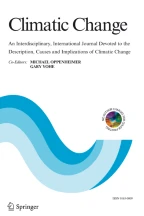4106Accesses
35Citations
39Altmetric
4Mentions
Abstract
Ocean iron fertilization has been proposed as a method to mitigate anthropogenic climate change, and there is continued commercial interest in using iron fertilization to generate carbon credits. It has been further speculated that ocean iron fertilization could help mitigate ocean acidification. Here, using a global ocean carbon cycle model, we performed idealized ocean iron fertilization simulations to place an upper bound on the effect of iron fertilization on atmospheric CO2 and ocean acidification. Under the IPCC A2 CO2 emission scenario, at year 2100 the model simulates an atmospheric CO2 concentration of 965 ppm with the mean surface oceanpH 0.44 units less than its pre-industrial value of 8.18. A globally sustained ocean iron fertilization could not diminish CO2 concentrations below 833 ppm or reduce the mean surface oceanpH change to less than 0.38 units. This maximum of 0.06 unit mitigation in surfacepH change by the end of this century is achieved at the cost of storing more anthropogenic CO2 in the ocean interior, furthering acidifying the deep-ocean. If the amount of net carbon storage in the deep ocean by iron fertilization produces an equivalent amount of emission credits, ocean iron fertilization further acidifies the deep ocean without conferring any chemical benefit to the surface ocean.
This is a preview of subscription content,log in via an institution to check access.
Access this article
Subscribe and save
- Get 10 units per month
- Download Article/Chapter or eBook
- 1 Unit = 1 Article or 1 Chapter
- Cancel anytime
Buy Now
Price includes VAT (Japan)
Instant access to the full article PDF.
References
Aumont O, Bopp L (2006) Globalizing results from ocean in situ iron fertilization studies. Glob Biogeochem Cycles 20:GB2017. doi:10.1029/2005GB002591
Boyd PW et al (2007) Mesoscale iron enrichment experiments 1993–2005: synthesis and future directions. Science 315:612–617. doi:10.1126/science.1131669
Caldeira K, Wickett ME (2003) Anthropogenic carbon and oceanpH. Nature 425:365–365
Denman K (2008) Climate change, ocean processes, and iron fertilization. Mar Ecol Prog Ser 364:219–225
Freestone D, Rayfuse R (2008) Ocean iron fertilization and international law. Mar Ecol Prog Ser 364:227–233
Gnanadesikan A, Sarmiento JL, Slater RD (2003) Effects of patchy ocean fertilization on atmospheric carbon dioxide and biological production. Glob Biogeochem Cycles 17(2):1050. doi:10.1029/2002GB001940
Monaco Declaration (2009) Second international symposium on the ocean in a high-CO2 world, Monaco, 6–9 October 2008.http://ioc3.unesco.org/oanet/Symposium2008/MonacoDeclaration.pdf
Martin JH (1990) Glacial-interglacial CO2 change: the iron hypothesis. Paleoceanography 5:1–13. doi:10.1029/PA005i001p00001
Pollard P et al (2009) Southern ocean deep-water carbon export enhanced by natural iron fertilization. Nature 457:577–580. doi:10.1038/nature07716
Raven JA et al (2005) Ocean acidification due to increasing atmospheric carbon dioxide. The Royal Society, London
Sarmiento JL, Orr JC (1991) Three-dimensional simulations of the impact of Southern Ocean nutrient depletion on atmospheric CO2 and ocean chemistry. Limnol Oceanogr 36:1928–1950
Seibel BA, Walsh PJ (2001) Potential impact of CO2 injection on deep-sea biota. Science 294:319–320
Wayman E (2008) Seeding the sea. Geotimes 53(8):40–47
Author information
Authors and Affiliations
Department of Global Ecology, Carnegie Institution, Stanford, CA, USA
Long Cao & Ken Caldeira
- Long Cao
You can also search for this author inPubMed Google Scholar
- Ken Caldeira
You can also search for this author inPubMed Google Scholar
Corresponding author
Correspondence toLong Cao.
Electronic supplementary material
Below is the link to the electronic supplementary material.
Rights and permissions
About this article
Cite this article
Cao, L., Caldeira, K. Can ocean iron fertilization mitigate ocean acidification?.Climatic Change99, 303–311 (2010). https://doi.org/10.1007/s10584-010-9799-4
Received:
Accepted:
Published:
Issue Date:
Share this article
Anyone you share the following link with will be able to read this content:
Sorry, a shareable link is not currently available for this article.
Provided by the Springer Nature SharedIt content-sharing initiative
